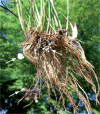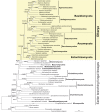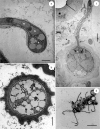Entorrhizomycota: A New Fungal Phylum Reveals New Perspectives on the Evolution of Fungi
- PMID: 26200112
- PMCID: PMC4511587
- DOI: 10.1371/journal.pone.0128183
Entorrhizomycota: A New Fungal Phylum Reveals New Perspectives on the Evolution of Fungi
Abstract
Entorrhiza is a small fungal genus comprising 14 species that all cause galls on roots of Cyperaceae and Juncaceae. Although this genus was established 130 years ago, crucial questions on the phylogenetic relationships and biology of this enigmatic taxon are still unanswered. In order to infer a robust hypothesis about the phylogenetic position of Entorrhiza and to evaluate evolutionary trends, multiple gene sequences and morphological characteristics of Entorrhiza were analyzed and compared with respective findings in Fungi. In our comprehensive five-gene analyses Entorrhiza appeared as a highly supported monophyletic lineage representing the sister group to the rest of the Dikarya, a phylogenetic placement that received but moderate maximum likelihood and maximum parsimony bootstrap support. An alternative maximum likelihood tree with the constraint that Entorrhiza forms a monophyletic group with Basidiomycota could not be rejected. According to the first phylogenetic hypothesis, the teliospore tetrads of Entorrhiza represent the prototype of the dikaryan meiosporangium. The alternative hypothesis is supported by similarities in septal pore structure, cell wall and spindle pole bodies. Based on the isolated phylogenetic position of Entorrhiza and its peculiar combination of features related to ultrastructure and reproduction mode, we propose a new phylum Entorrhizomycota, for the genus Entorrhiza, which represents an apparently widespread group of inconspicuous fungi.
Conflict of interest statement
Figures







References
-
- Weber C (1884) Über den Pilz der Wurzelanschwellungen von Juncus bufonius . Botanische Zeitung 42: 369–379.
-
- Vánky K (2012) Smut Fungi of the World. St. Paul: APS.
-
- Fineran JM (1980) The structure of galls induced by Entorrhiza C. Weber (Ustilaginales) on roots of the Cyperaceae and Juncaceae. Nova Hedwigia 32: 265–284.
-
- Deml G, Oberwinkler F (1981) Investigations on Entorrhiza casparyana by light and electron microscopy. Mycologia 73: 392–398.
-
- Fineran JM (1978) A taxonomic revision of the genus Entorrhiza C. Weber (Ustilaginales). Nova Hedwigia 30: 1–67.
Publication types
MeSH terms
Substances
LinkOut - more resources
Full Text Sources
Other Literature Sources
Medical
Molecular Biology Databases

